
























With its fighting spirit, thanks to highs and lows as numerous as the hills that blanket it, the River City holds more than just the “Key to the South,” as Lincoln famously said.
It holds the key to the past as well, thanks to decades of people who committed their lives to the preservation of its history. While Vicksburg is known for its economic prowess with the booming port complex, a thriving merchant scene and more than a few career researchers with the U.S. Army Corps of Engineers, the bread and butter of this town hinges on its history.
People travel from across the world to stand along the banks of the Mississippi River. They stand solemnly in the rotunda of the Illinois monument, peering out at the Vicksburg National Military Park and imagining the valiant bloodshed.

They relish in the hospitality of its people, desiring to stay in our worldclass historic mansions. They delight in our cuisine, hearing tales of the birth of the Mint Julep and the secret to a perfect Vicksburg Tomato Sandwich.

And possibly, they envy those of
us who are blessed enough to call our fair city home, for we are the ones who get to live in and amongst all of this life-giving culture.
We drink coffee in a building that once financed freed men’s dreams. We sup in the Confederate President’s brother’s home. We live and work in buildings that are scarred from years of manmade and natural disasters — and we preserve those scars, every mortar shell, every craggy brick.
All of this makes up the charm of our city, and we are truly blessed to
share it with others.
Doing so 160 years after our darkest hour shatters preconceived notions and highlights the many ways we carry — or try to move beyond — the sins and triumphs of our forefathers.
As you read the 2023 edition of PROFILE, our cornerstone publication, it’s our hope that you will see the beauty and the tenacity of our city and its people. Vicksburg is truly a place suspended between the past and present, but in finding that balance, we can look toward its future.
MANAGEMENT
Catherine Boone Hadaway President / Publisher 601-636-4545 Ext. 1300 catherine.hadaway@vicksburgpost.com
Anna Guizerix Managing Editor 601-636-4545 Ext. 1307 anna.guizerix@vicksburgpost.com
ADVERTISING
Raegan Pope 601-636-4545 Ext. 1122 raegan.pope@vicksburgpost.com
Mallory Hoffman 601-636-4545 ext. 1309 mallory.hoffman@vicksburgpost.com
NEWSROOM
Ernest Bowker, Sports Editor 601-636-4545 Ext. 1304 ernest.bowker@vicksburgpost.com
Terri Cowart Frazier, Reporter 601-636-4545 Ext. 1303 terri.frazier@vicksburgpost.com
Ben Martin, Reporter 601-636-4545 Ext. 1308 ben.martin@vicksburgpost.com
John Surratt, Reporter 601-636-4545 Ext. 1302 john.surratt@vicksburgpost.com
BUSINESS OFFICE
Shandale Goodman, Bookkeeper 601-636-4545 shandale.goodman@vicksburgpost.com
Vera Ann Fedell, Office & Newsroom Assistant 601-636-4545 vera.fedell@vicksburgpost.com
Profile 2023 is a product of The Vicksburg Post, produced by Vicksburg Newsmedia, LLC.
SPECIAL THANKS
Profile 2023 would not be possible without the help of the following:
The Old Court House Museum

Charles Pendleton and the Vicksburg Civil War Museum
Tommy Presson
The Southern Cultural Heritage Foundation Vicksburg National Military Park
Golding Barge Line transports refined petroleum products, chemicals, and petro-chemicals throughout the entire U.S. inland waterway system.










Patience Potticary Gamble didn’t do much more to become famous than cross the street — but the legacy of her family is one that’s endured in Vicksburg for six generations.
Today, the family’s history is shouldered by Patience’s direct descendants: Karen Gamble and her nephew, Sam Andrews, who both trace their lineage through Patience’s son, Franklin Pierce Gamble, the only one of her eight chil-

dren to remain in Vicksburg in the years following the Civil War. Gamble’s thoughts on her great-great-greatgrandmother are fairly simple: Thank God we don’t share a name.
“My biggest thought is, I’m thankful to God for my mother because it turns out that, historically, in our family, dating back to Andrew Jackson Gamble and Patience Potticary Gamble and all the offshoots, people in the Gamble family had named children for this person or that person,” she said. “My father wanted to name me,
“My biggest thought is, I’m thankful to God for my mother because it turns out that, historically, in our family, dating back to Andrew Jackson Gamble and Patience Potticary Gamble and all the offshoots, people in the Gamble family had named children for this person or that person. My father wanted to name me, the second child, Patience Potticary Gamble. And my mother said, ‘Hell no.’ As it turned out, it was quite fortuitous because I am not patient.”
the second child, Patience Potticary Gamble. And my mother said, ‘Hell no.’ As it turned out, it was quite fortuitous because I am not patient.”
An English immigrant who married an Irish immigrant, Patience and her husband Andrew Jackson Gamble built themselves up from very little to relative prominence in Vicksburg, thanks to Andrew’s successful marble monument business. An eagle-eyed passerby in Cedar Hill Cemetery will see no fewer than a dozen headstones marked “GAMBLE” on the back, denoting his work.
In addition to their eight children, the Gambles also had a home on Cherry Street (which was later bulldozed to make room for Carr Central High School) and a summer home across town on what is now called Mundy Street. It was while walking to a cave from this house, seeking shelter from Union shelling of the town, that Gamble was struck by a shell and killed on June 28, 1862.
Her name was then etched in history as the first civilian casualty of the Siege of Vicksburg. However, both Karen and Andrews said that’s not the end of their story. Thanks to a maiden aunt, Anna Claire Gamble, whom Karen described as the “holder” of the family, the legacy of Patience lived on.
“Anna Claire and her family and her parents before her and their parents were all quite aware of Patience Potticary Gamble and there
was a sense of pride,” Karen said. “The fact that there were Gambles in Vicksburg for so many years, and right now, I’m a Gamble by blood — but I refused to take my husband’s name because I knew I’d be the last Gamble; I am today the only Gamble by name left in Vicksburg.”
Being yet another generation removed from Patience, Andrews (whose middle name is Gamble) said he finds pride in his family’s legacy in Vicksburg, beginning with Franklin Pierce Gamble — whom some reports indicate was holding his mother’s hand at the time of her death.
“Their story’s had to wind its way down over time,” Andrews said. “The Gambles came here as immigrants but in the years that followed, they acquired a sizeable estate. They got here relatively obscure, but I think the defining characteristic of these people was that they made something of themselves. That’s something that is the overriding theme of these people.”
Frank, as his descendants affectionately call him, worked at a foundry downtown and became “one heck of an upstanding citizen,” Andrews said. “They got here with nothing but chose to make something of themselves.”
In addition to the hardworking spirit of those who came before them, Karen and Andrews said they find solace in knowing the Vicksburg they know in 2023 isn’t as far removed from the city of 160 years ago.
“When I was a child growing up in Vicksburg, I had a classmate, Marilyn Jamison, who lived in the house on Mundy Street right where Patience was killed,” Karen said.

Andrews echoed his aunt’s sentiments, adding that, as someone who lives in the Vicksburg Historic District and owns Anchuca Mansion with his wife, Anna Kate Doiron Andrews, he is in the unique position of living mere blocks from where his family’s history began.
“Four blocks from Anchuca is where she was killed. Today, you’ve got a sixth-generation descendant who lives blocks away from where she lived. I hadn’t been to a whole lot of places, but that seems pretty rare to me,” Andrews said. “As a younger person, it’s amazing to know that the place where you live with your family, where your business is, the places where you’re walking and the things you’re doing are steps away from where all this took place. That doesn’t happen everywhere.”
In the near future, Karen and Andrews said, along with their family they are working with the Mississippi Department of Archives and History to erect a historic marker in Patience’s memory.
It will be funded in full by the family, Andrews said, because Patience was “the giver of charity, not the recipient of charity.”
“A Brigadier General M.L. Smith’s report of Vicksburg reads, ‘The report of the struggle of Vicksburg would be incomplete without the








following merited tribute: During an engagement on the 28th, a most-esteemable lady, Mrs. Gamble, lost her life by the fragment of a shell striking her while leaving the city.’ That says just about everything you need to know,” Andrews said.
Anchuca Mansion provides a glimpse into Patience’s life and death. Although she never lived in the home, Andrews has outfitted it with reminders, clippings and photographs to commemorate his great-great-great-great-grandmother. And one special piece of furniture is there as well — her potty chair, tucked in the corner of the ladies’ parlor.
Thelma Sims Dukes is but one of many descendants of William “Bill” Sims, and counts herself lucky to have ties to Vicksburg.

Sims was Dukes’ great-great-grandfather, a man born into slavery who ultimately served with the Third U.S. Colored Calvary in the Union Army during the Civil War and fought at Milliken’s Bend. In 1896, Sims purchased 100 acres of land in the Freetown community in Warren County.
Today, 10 acres of land remain in the family’s possession, with Dukes as one of the chief preservationists of the property. The family carries with them a particular devotion to keeping the land as a gathering place for reunions and a monument to Sims’ life.
“I didn’t grasp as a child or a young person the importance of my great-great-grandfather’s service in the Civil War,” Dukes said. “My father died young, so stories that might have been told were lost. My awakening of (Sims’) service came with Vicksburg’s first Black Mayor, Robert M. Walker, and his 15-year struggle to get the ‘1st and 3rd Cavalry Commemoration for their participation in the Vicksburg Campaign,’ monument.
“It was the first honor for Blacks in a national park in the country,” she added. “That was 139 years after the Civil War ended.”
Sims died in 1930 at the age of 91 — in Freetown.
Dukes said she treasures her family’s history in her heart, because she knows many Black people can’t trace their history the way she has. The way she put it is, “history is late in coming to us,” when referring to the fear many of her ancestors felt in telling their stories.
“Now that I know the true history of his service, (Sims) was more of a Freedom Fighter than a soldier,” Dukes said.“(Growing up), I was proud, but I had no understanding. Today, I am so proud of him and to know that he fought in that awful Milliken’s Bend battle so bravely, is chest-bursting.”
Dukes, who now lives in Jackson but spends much of her time in Vicksburg, said she feels pride in her heritage, knowing the fruitful life her twice-great-grandfather was able to lead after the Civil War. That sense of pride is what inspired her to hold on to her maiden name — even what kept her from changing her name to one of African etymology.
“I didn’t want to shed the Sims’ part because of
my relationship to William ‘Bill’ Sims,” she said. His descendants are still working to develop more of the memorial park established in his honor. As the William “Bill” Sims Foundation historian, Dukes serves as the mouthpiece for her family.
It is vital to the younger generations, she said, to keep perpetuating the history of her great-great-grandfather — not only so he isn’t forgotten, but so his story may inspire others as they face adversity.
“As in all of our lives, the endurance of our ancestors is what sustains us,” Dukes said. “It is true that we live in the state of twoness, that the brilliant scholar W.E.B. Dubois said was a double consciousness. I try hard to keep the two souls from warring. I try to pass on the knowledge of the struggle for Black people to use to keep their souls from being torn asunder.”
Jane Lauderdale Flowers is a lifelong Vicksburger, but she only recently learned how deep her family’s roots run in the River City.
Being inspired by two friends, Rosemary Etheridge Palermo and Anne Claire Fordice, who were not only bitten by the genealogy bug, so to speak, but were also able to establish a family connection with Flowers by tracing ancestry, Flowers did a little digging of her own.
“Living here all my life and finding out that my great-great-grandfather, John Francis Lauderdale, was a Confederate soldier and that he’s buried in the city cemetery, nobody ever told me that,” Flowers said. “He was injured twice and in some of the toughest battles, and he’s out there in Soldier’s Rest.”
Flowers was referring to her Lauderdale family, on her father’s side, who settled in Vicksburg after the Civil War. But her mother’s side also had ties to Vicksburg, she soon discovered. The history of Andreas Jenne, Flowers’ great-great-grandfather on her mother’s side, extends past the Civil War.
Jenne, a German immigrant, owned Magnolia Coffee House on Levee Street. He died in 1859, leaving at least one child to survive the Siege of Vicksburg.
Now retired, Flowers spends much of her time giving tours of historic Vicksburg. Knowing her family’s ties to the city, she said, is something she cherishes as she leads others back in time.
“Sometimes, when I give the tours, I kind of wonder what life was like for them back then,” she said. “It was a tough time.”
Christ Episcopal Church, for example, was the site of an 1874 wedding of George Jenne, her great-grandfather.
It’s not just walking in and amongst the history each day that fascinates her, Flowers said; it’s also the thrill of the hunt, finding clues to her family’s past. For example, newspaper ads or stories mentioning her twice-great-grandfather’s coffee shop are a wealth of information.
Flowers isn’t just practicing as a scrapbooker of historic clippings, either. She currently has Trent Lewis, the Cemetery Doctor, working to repair Andreas Jenne’s obelisk in Cedar Hill Cemetery.
“The obelisk has fallen off the tombstone,” she said. “It was put there in 1859. And around it, there are symbols of children that died and others buried underneath that tombstone.”
Flowers said she didn’t grow up with a sense of pride in her family’s history, because she simply didn’t know it.
However, she now finds a sense of pride and of honor to be a part of one of Vicksburg’s many multi-generational families.
“I guess I never had thought about this growing up since I didn’t know that my great-great-grandfather, Andreas Jenne, was here before the Siege,” she said. “I have always been so proud to be from Vicksburg and knowing this history now helps me to realize why I have loved my hometown so much.
“I can’t imagine my great grandfather, George Jenne, being 12 and living here through the Siege. Knowing that he got married for the first time in Christ Episcopal Church in 1874 makes this history just come alive,” she added. “And also learning that my great-great-grandfather on my mother’s side, a Yankee who came to Vicksburg soon after 1860, and stayed here until he died also lets me know how much my family loved this area. Two of my three children live here and we enjoy our hometown.”
The Halpin surname has become synonymous with Vicksburg’s entrepreneur and merchant community over the last 160 years — but Vicksburg is only home to a few remaining descendants.
Will Halpin is one of those, and coincidentally, the Halpin family’s legacy in the River City doesn’t start with a Halpin at all, but with a man named Wallin.
Eric William Wallin (pronounced Wall-een), is Halpin’s great-great-grandfather and was the Mayor of Vicksburg from 1866 to 1867. His shortened term as mayor was due in part to the Union occupation of Vicksburg following the end of the Civil War.
“The story we heard throughout the years was that he resigned,” Halpin said. “But he was instrumental in getting the Constitution Firehouse built. The first horse-drawn fire engine came in, and it had a sign that read “E.W. Wallin, Mayor, 1867,” on it.
Moving up a generation, Wallin’s daughter, Barbara, married John Francis Halpin I between 1870 and 1880, and that’s when the family really rose to prominence.
John Halpin, borne of Irish immigrants whose family first immigrated to Cincinnati, Ohio before settling in Vicksburg, became well-known in the Vicksburg area as an entrepreneur.
“John F. ended up doing very well for himself,” Halpin said. “He was a true entrepreneur. He was a grocery wholesaler, he opened a bank with John Alexander Klein and on the murals (at the Vicksburg waterfront) the first one you come to, if you look on the back of the building, it says ‘Halpin and Bowen’ on it.”
The way the family wound up in Vicksburg, Will said, was either by sheer misunderstanding or perhaps, fortune.
“John F.’s father, Jeremiah Halpin, was one of 13 children. Jeremiah heard the streets were paved with gold in Vicksburg, Mississippi, so he puts the
family on the riverboat heading South,” he said. “They get off at Vicksburg only to find out it looked like gold when the sun set on the brick streets. We heard that story growing up our whole lives.”
Unlike Wallin, with his political aspirations, a faction of the Halpins owned a saloon near what is now known as the Jackson Street Community Center.
Will said he’d once aspired to reopen the bar but decided he’d better stay out of that business.

In the years following the Civil War, the Halpin name rose to further prominence. In the Eagle Lake Area, Halpino Lake remains as an homage to Halpino Plantation, which was established after the war and jointly owned by John Francis Halpin I and Wallin.


Halpin I did well in the banking business, but it also proved to be his demise.


“The bank went solvent, and he made sure every depositor was repaid,” Will said. “That’s the way he lost his fortune, or at least the way we always heard. We also heard that the second generation of the family sat on the front porch and drank it away, so who knows.”
Coming from a long line of strong personalities and colorful, hardworking characters is something in which Will said he finds great pride. It’s also been his motivation to remain in town and close to his roots over the years.
“The main reason I stayed in Vicksburg is, it’s like the old show ‘Cheers.’ I know everybody, and everybody knows me,” he said. “I’ve traveled the world, all over the country, and the best sentence in the English language is ‘I’m on the way home.’
“I was born a Vicksburger, and I’m gonna die a Vicksburger.”
“John F.’s father, Jeremiah Halpin, was one of 13 children.
Jeremiah heard the streets were paved with gold in Vicksburg, Mississippi, so he puts the family on the riverboat heading South. They get off at Vicksburg only to find out it looked like gold when the sun set on the brick streets. We heard that story growing up our whole lives.”

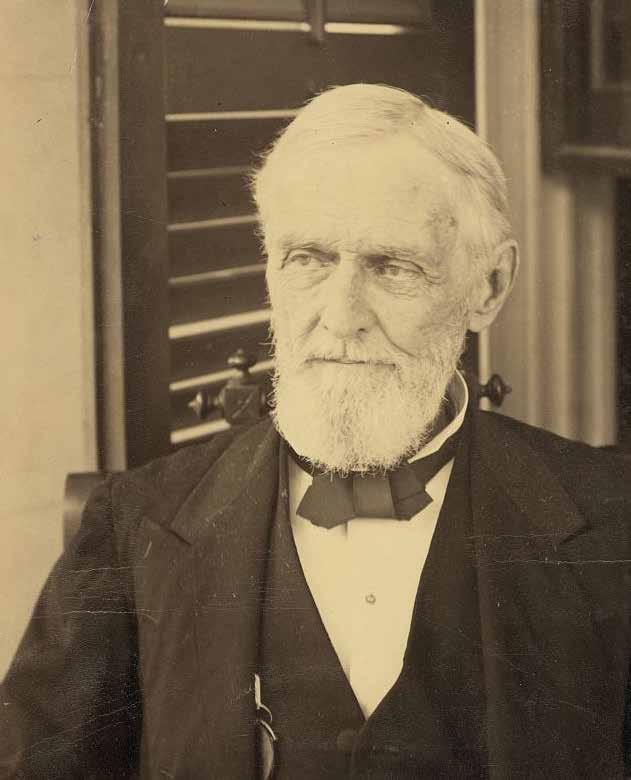
To the majority of Americans, Jefferson Davis’s life is condensed to four years in which he served as the President of the Confederacy — however, every coin has two sides.
One Vicksburg resident with intimate knowledge of the man has spent nearly 50 years working to change that perception — or at least show visitors to Vicksburg that there is more to Davis’ life than those four years. However, Bertram Hayes-Davis, one of Jefferson Davis’s great-greatgrandsons, didn’t start out with a wealth of knowledge about his forefather.
“When I grew up, there was a painting on the wall, and books underneath the radio, and my whole knowledge of Jefferson Davis was, ‘President of the Confederate States of America,’” Hayes-Davis said. “I didn’t know anything else until 1976 when I was a little bit older and was invited to Montgomery to give a speech in front of 500 people, and I didn’t know anything about my great-great-grandfather
Hayes-Davis set forth learning about his great-great-grandfather via pilgrimage, traveling to every point on the map where Davis trod, all the while reading Davis’s writings and significant texts written about him.
It’s a path that brought him and his wife, Carol, to Vicksburg, where they established a residence and founded Vicksburg Old Town Tours, which takes visitors through significant places in the city’s Civil War history. For Hayes-Davis, it’s also a way to get closer to understanding who Davis was — and why his contributions are far beyond that of a turncoat.
“I’ve read the biographies and the Pres. Jefferson Davis papers, but it’s a different thing when you sit there, or when you walk up the street to Christ Church or Duff Green or Anchuca, knowing this is the same street that he walked on,” Hayes-Da-

vis said. “This is his hometown. He moved here in 1835 after the loss of his first wife. He moved here with his brother, Joseph, and established his residence here. And we, as a family, owned that property until 1952. We’ve been here a long time, and this is the home — Brierfield, the home we knew was his.”
Jefferson Davis lived at Brierfield alongside his brother, Joseph Davis, who lived at Hurricane Plantation, at Davis Bend.

Joseph Davis split his time between Hurricane and Anchuca Mansion, which is seated comfortably in the heart of Vicksburg’s oldest neighborhood. Brierfield House burned down in the 1930s, but the bricks used to raise the house are still on the island.
“We go over there frequently and I can stand exactly where it was,” Hayes-Davis said.
Through his and his wife’s work giving tours and documenting Davis, whom his
great-great-grandson calls “One of the most misunderstood figures in American history,” Hayes-Davis said their goal is singular, presented free from agenda or politics.
“What we’re doing is, we’re preserving history. We’re not walking away from it, or discarding it, we’re bringing the facts. We have no agenda, other than the facts,” he said. “We’re not saying, ‘Jefferson Davis was the greatest person in the whole wide world, or Vicksburg is the greatest town in the world.’ What our vision is, is that this is what it is. When we repeat the history of my great-great-grandfather before he was President, people are amazed at all the things he did.
“We fit Vicksburg into that, because this is where he was. He lived here, he walked the street every day. The same steps.”
Amazed could be an accurate description, as the 30-year chapter between Davis’ arrival in Vicksburg and his capture and imprisonment after the war holds several glimpses into who he was.
Prior to arriving in Vicksburg, Davis served in the U.S. Army, graduated from West Point and married President Zachary Taylor’s daughter, Sarah. When Sarah died at age 21 in St. Francisville, La., Davis moved to Vicksburg. The year 1835 was a pivotal one for Davis not just through the move to Vicksburg; it’s also the birth of Davis, the politician.

Davis is elected to the U.S. House of Representatives, serves in the Mexican-American War, spends time in the White House with his ex-father-in-law and comes home to Vicksburg to (unsuccessfully) run for Governor. He ends up being appointed Secretary of Defense by President Franklin Pierce and through that appointment he grows the U.S. Army and works to expand the U.S. Capitol Building. Davis also completed a survey of the Trans-Continental Railway prior to becoming a senator.
The Hayes-Davises, although not from Vicksburg, made it their home and say they have a special devotion to keeping Vicksburg moving forward.

Part of accomplishing that goal of forward momentum, they said, is embracing the city’s history and sharing its story with others.
“I’ve seen the deep roots of the town, the people that are here and who have been here a long time. I think there is significant ownership of the history of Vicksburg,” Bertram said. “There is a lot of pride in being from Vicksburg. Bringing this pride and history forward, it’s a continuance of, ‘We are Vicksburg,’ and we
can be Vicksburg with the potential for us to be better than we were yesterday.
“Vicksburg still has potential; it’s teeming with it,” he added.



Carol said her joy is found in the faces of those who’ve never experienced Vicksburg, or Mississippi, before.


“We do these tours, and we do a lot of them. And people come here and they’re not expecting what they find. And it’s a joy,” she said. “Most people say they’d never come to Mississippi. It doesn’t have a reputation of being someplace where people want to go. But they come here, and they’re
blown away by the beauty of the state, they’re blown away by the people.”
The structure of the city, its good and bad parts and the way it ebbs and flows, is what keeps people coming back — and makes them want to stay.
“There are so many people who don’t know about our history or don’t focus on it, and that’s true everywhere. But when you’re talking about people coming here, they see what you’re talking about,” Carol said. “... It’s a true neighborhood we’re in, and it’s rare. I don’t know if there is another place like that. If there is, we haven’t found it.”
“What we’re doing is, we’re preserving history. We’re not walking away from it, or discarding it, we’re bringing the facts. We have no agenda, other than the facts. We’re not saying, ‘Jefferson Davis was the greatest person in the whole wide world, or Vicksburg is the greatest town in the world.’ What our vision is, is that this is what it is. When we repeat the history of my great-great-grandfather before he was President, people are amazed at all the things he did.”PHOTO BY RAEGAN POPE| THE VICKSBURG POST Bertram Hayes-Davis and Carol Hayes-Davis at their home in Vicksburg.
 By Ernest Bowker | The Vicksburg Post
By Ernest Bowker | The Vicksburg Post
Footsteps tap the pavement behind you, keeping up with every step. From somewhere in the distance, stony eyes follow your every move.
In the darkness, on a lonely street, a hand reaches out for a touch and whispers in your ear as a chilly breeze rustles the leaves.
If you’ve ever experienced any of these sensations — and, if you live in Vicksburg long enough, odds are you have or will — congratulations. You’ve just added to the city’s long and colorful history of ghost stories.
“Science will tell you it’s all hogwash. But when you get enough reputable people telling you their stories, there is something there,” said Morgan Gates, who operates a seasonal ghost tour business called Haunted Vicksburg.
Gates’ tours, which can be booked through HauntedVicksburg.com, take people around the city as he tells patrons about its supernatural side.
“I’m not a ghost hunter,” Gates said. “I collect stories.”
Some of Vicksburg’s ghost stories are well-known, oft-repeated tales centered around the antebellum homes that have been turned into 21st-century bed and breakfasts. Those, though, only scratch the surface.
Over the course of two centuries Vicksburg has accumulated a number of spirits who creep through all of its corners and crevices. The city has seen its share of pain and suffering as a wild 19th-century river town that also endured war and disease, all feeding the flow of negative energy believed to make a place haunted.
“Most old towns do have something to it. When you think of haunted cities you think about Savannah or New Orleans, and Vicksburg is right there with them. We just have so much history that sometimes that door peels back and you see something.”
“Most old towns do have something to it,” Gates said of the level of ghostly activity in Vicksburg. “When you think of haunted cities you think about Savannah or New Orleans, and Vicksburg is right there with them. We just have so much history that sometimes that door peels back and you see something.”
Vicksburg’s most famous bit of history, of course, involved plenty of death. The long campaign to capture the city during the Civil War, and the 47-day siege that finally did it in 1863, left many unsettled spirits in its wake.
Nearly 8,000 soldiers died or went missing during the long battle. Plenty, it seems, have hung around ever since. The Vicksburg National Military Park is notorious for sightings of ghostly soldiers and other strange phenomena.
Visitors have reported hearing loud footsteps behind them, like a group of people approaching, only to turn and see nothing.

Roads supposedly glow at night, while granite and bronze statues cry blood for their fallen comrades.
Bess Averett, the executive director of the Friends of the Vicksburg National Military Park and Campaign, said local residents often told stories of things they’d witnessed in the VNMP in decades past when traveling through it at night was common. The Park is now closed to the public after dark.
“The Park’s Tour Road was part of Vicksburg, and you drove through it to get places,” Averett said. “Supposedly, if you pulled in front of the Pennsylvania Monument at night and your headlights hit the five faces they were crying tears of blood for their soldiers.”

Another story, Averett said, centers around the statue of Ulysses S. Grant and his horse near the Union general’s headquarters. At night, the statue is said to disappear as the general rides along the lines to check on his men.

“I have been in there at night and he’s there, so that’s not true,” Averett said with a laugh.
When Grant stands still — which is often, since he is a granite and bronze statue, after all — his eyes are said to follow the Park’s visitors everywhere they go.
Averett had plausible explanations for some of the stories. It’s believed that rust on the Pennsylvania monument causes the “bloody tears” people have witnessed. Grant’s gaze, she reasoned, probably comes from the way the statue was sculpted.
“It probably is the way he’s cast,” she said. “I know there are paintings that it looks like that no matter where you look, the eyes are following you. I’m sure there’s a way you can do that with sculpture and maybe that was implemented there.”
Other phenomena are not so easily explained.
“Graveyard Road is the place where all those men died during the assault, and one night you could see the road glowing. Or you could see soldiers walking just ahead of you,” Gates said.
One story Gates likes to share is that of an Irish immigrant known only as “The Digger.”
The Digger was a miner who was passing through Vicksburg as the Union army closed in, and wound up trapped in the city. He found lucrative work digging caves for the city’s residents to live in, until one of the caves collapsed and killed several children.

Later in the Siege, the Digger was pressed into service by the Confederate army to dig a countermine as Union forces tried to tunnel under and explode Rebel earthworks.
As he worked, the Digger heard Union miners working just on the other side of his own tunnel. He ordered his crew to stop working and ready their rifles as he punched a hole into the wall — only to reveal the ghastly faces of withered children and a lit fuse.
The mine exploded, killing the Digger and his crew. Occasionally, however, people report seeing lights appearing in holes in the ground around Vicksburg.
“Don’t be alarmed,” Gates said with a grin, “For it is just ... the Digger.”
And don’t be alarmed, Gates added, if you see a lonely, tattered soldier in the woods. Or hear a voice that comes out of nowhere. Or even feel a touch on your back, like he once did while loading up some equipment one night. For they are just ... the ghosts of Vicksburg.
“When I started doing this in 2010, it was bed and breakfasts and horrible history, things like that. Since then I’ve heard all kinds of stories. People want to tell you their stories,” Gates said. “You talk to people and everybody has their own ghost story.”
We're proud to have updated features throughout the academy with proudly decorated and well-equipped classrooms, lunchroom sunny courtyard & outside areas art classes, dance classes and enriching field trip destinations








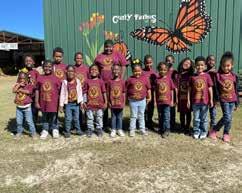
Behind the façade of a 58-year-old woman lies the spirit of a young girl, only 10 when she was subjected to the atrocities of living in a war zone.
In 1912, barely 50 years after the Siege of Vicksburg, Lucy McRae Bell, now grown, sat down to reckon with her past. The family lived in Vicksburg in the home now known as Planter’s Hall, which, prior to the Siege, was handsomely outfitted for the McRae family: Lucy’s parents, William Allen McRae and Indiana “Indie” Rozell McRae, and her two siblings all knew relative comfort and peace. That is, if
there was such a thing in a river town as rough around the edges as Vicksburg.
The McRae family was indeed well-to-do, but when the Siege began in April 1863, it was 47 days of hell that left no one spared regardless of status, race or creed.
Lucy, who eventually left Mississippi behind and moved to Indiana as an adult, wrote her account for Harper’s Weekly. Though she was long removed from her childhood on the Mississippi River, her account, now known as “A Girl’s Experiences in the Siege of Vicksburg,” was just that — she revisited the Siege not only

in her mind, but in her spirit as well.
She described the experience as “indelibly impressed upon my mind,” writing in her essay that she often was questioned about her recollection of the Siege so many years after the Civil War ended. Her response settled any speculation.
“My answer is that, being shut up in the place, living in a cave under the ground for six weeks, and being endowed with a good memory, facts and circumstances were impressed upon my mind; besides, I do not think a child could have passed through what
“We were all sitting outside the cave, twilight approaching, when father came in sight. Mother thought father had decided to die with his family the next day, for everybody thought that General Grant would make the effort of his life to take the city on the 4th. Father came to mother, looking sad, with tears in his eyes, and said, ‘You can all come home for a night’s rest. General Pemberton has surrendered, and General Grant will enter the city in the morning.’”
I did and have forgotten it,” she wrote. Her story begins with an ominous scene: her mother and others in town standing on balconies and hills with spyglasses trained on a black figure moving down the Mississippi River toward town. That Union gunboat brought with it a steady stream of shelling that claimed the life of Patience Potticary Gamble, who was retreating to a cave with her child from their house on modern-day Mundy Street. The cave was located in the rear of what is now Cedar Hill Cemetery.
While Lucy’s father refused to leave their home at 822 Main St., he sent his wife and children 30 miles away to the hamlet of Bolton’s Depot. They were safe, briefly, until the battle of Champion Hill. Then, as the family fled back to Vicksburg, they inadvertently served as torchbearers for Gen. Ulysses Grant and brought behind them a level of hell never before experienced on the River City’s soil.
Lucy’s story touches a number of significant locations in the Siege story — Hurricane Plantation, home of Joseph Davis (Jefferson Davis’s brother) and the prolific Montgomery family; Pemberton’s Headquarters; and of course the 500 caves nearly every citizen fled to when their homes were no longer safe.

The McRae family stayed in two different caves, the first with some 200 people.
That time was short-lived, as a landslide triggered by a shell embedding itself 6 feet into the earth and exploding left Lucy buried under a pile of earth. She was pulled out head-first as shells exploded around the party.
“The blood was gushing from my nose, eyes, ears, and mouth,” she recalled in 1912.
However, Lucy wrote, there was a flicker of joy in the moment that nearly snuffed out her life: A baby was born in the back of the cave in the midst of the chaos. He was named William Siege Green — son of Duff Green, whose iconic mansion still stands today in Old Vicksburg.

The morning after her near-death experience, Lucy’s mother decided to make a run for it and head home. Surely, Lucy wrote,
it would’ve been better to take the risk of staying in their home.
The family, like others during this time, became skilled at avoiding airborne shells, running toward them and away from the impact points and ducking when necessary.
“As a great mortar shell would come over with its rumbling noise, which I shall never forget, one of my brothers would say ‘Run along, poor little thing,’ and my remembrance is that I was indeed a poor little thing.”
Her father sent the family to another cave closer to home, which was smaller and, they hoped, safer. Times got worse, though, as the Louisiana soldiers resorted to eating rats and mules to survive.
Grant’s army was succeeding in choking the life out of Vicksburg, but the battle raged on.
Lucy’s mother was never desperate enough to eat mule meat, she wrote, but the children did “and it tasted right good.”
After witnessing a young woman meeting her death after being pinned under a mortar shell, the McRaes, Rice and an enslaved nursemaid, Mary Ann, fled once again before they were caught in the midst of a grisly battle.

“Not a word was spoken except ‘run,’ and we did run.”
Although their home was hit with shells, it sustained no major damage during the Siege. However, McRae recalled, a Minié ball did pass through his whiskers before lodging in a rocking chair nearby.
McRae wrote, that, 50 years on, she still had the one-sheet Vicksburg Evening Post edition printed on wallpaper as a souvenir from the awful time.
Her story comes to a close on July 3, 1863. The eerie silence after 47 days of hellfire surely meant only one thing: July 4 was to be the day of reckoning for the people of Vicksburg and the Southern army.
However, as is now etched in history, that was not to be the case.



“We were all sitting outside the cave, twilight approaching, when father came in sight. Mother thought father had decided to die with his family the next day, for everybody thought that General Grant would

make the effort of his life to take the city on the 4th. Father came to mother, looking sad, with tears in his eyes, and said, ‘You can all come home for a night’s rest. General Pemberton has surrendered, and General Grant will enter the city in the morning.’”
She recalled the next day, the defeat and the bitterness and the quiet relief that the worst might be over.
Grant’s army came into the city through Jackson Road and Glass Bayou Bridge, and a separate faction arrived by the Mississippi River.


“The riverfront presented a scene of unsurpassed grandeur. To say that the scene looking from the upper porch of our residence, where we commanded a fine view, was superb in its magnificence is to say little. The inspiring grandeur of gunboat after gunboat, transport after transport, with flags flying to the breeze, broadside after broadside belching forth in honor of a victory dearly won, bands playing, made a picture that can never fade from memory.”
The juxtaposition of Union patriotism and Confederate decimation is something McRae said she found puzzling but had long tried to reconcile in her mind.
“Men looked so forlorn, some without shoes, some with tattered garments,


yet they would have fought on.”
McRae died in October 1930 at age 76, and no more than three generations separate her from those walking the streets of Vicksburg today.
Jordan Rushing, a historian at the Old Court House Museum in Vicksburg, said Lucy McRae’s account of the Siege is a significant piece of literature because it provides a link between the city’s past and present.



“There are a lot of similarities in Vicksburg then and Vicksburg now,” Rushing said. “A lot of what we notice about Vicksburg now developed between that 1870-1890 Vicksburg; Lucy probably saw a lot of that shift.”

Her account of the Siege having wide distribution was also significant, he said, because it provided a perspective of the Civil War many Americans wouldn’t have seen otherwise.
“Being able to have that experience in the 1860s and being able to write about it at the national level, she gave that perspective to thousands of people,” he said. “It’s a primary and secondary source all wrapped up into one. From a child’s perspective, they don’t know what’s normalized. To be able to review her experience in retrospect, historically it’s wonderful and psychologically, it’s remarkable.”


Unbeknownst to many a Union soldier, there were spies among them — women spies.
Perhaps the guile of these women went unnoticed due to the notion a “lady” would never behave in such a fashion. Or maybe these soldiers were just unaware of their capabilities.
One of these female spies was Vicksburg resident Emma Kline. Kline’s actions came following the surrender of Vicksburg on July 4, 1863.

Described as “hostile in spirit” by Vicksburg native and author Jeff Giambrone, Kline was among a group of women who smuggled muchneeded supplies out of Vicksburg into an area east of the Big Black River, which was still held by the Confederacy.
In doing so, she was arrested for smuggling by Alonzo L. Brown,




captain of Company E, 50th U.S. Colored Infantry.
Brown’s account of the incident as published in The Vicksburg Herald on April 16, 1908, stated, “Capt. Brown said that as Kline and a friend approached his post to leave the city, ‘The writer could hardly repress a smile as he noticed their distended skirts. He informed Miss Kline that he had received instructions not to allow her to go through the lines, but to send them back to the city under guard.’”

Kline was imprisoned, but before she was sent to jail, a photograph was taken in 1864 of the 20-year-old in which she is standing between two guards from the 5th Iowa Infantry.
Kline died in 1878, shortly after the birth of her daughter and namesake, Emma Lane. The cause of her death may have been complications from childbirth or a Yellow Fever epidemic that scourged
Vicksburg in 1878. She is buried in Asbury Cemetery, located just south of Vicksburg.
Kline was referred to as a “hoop-skirt smuggler,” because ladies’ clothing of the era included crinoline, which was a rigid, cage-like structure worn under skirts that, at the height of its popularity, could reach a diameter of six feet.
Historians say female spies of the time capitalized on the “cumbersome and cavernous garments” by using them to hide all kinds of loot.
It has even been said that one woman “managed to conceal inside her hoop skirt a roll of army cloth, several pairs of cavalry boots, a roll of crimson flannel, packages of gilt braid and sewing silk, cans of preserved meats and a bag of coffee,” one expert on the era wrote.


Now, that’s a lot to stuff up a skirt.

Brown’s account of the incident as published in The Vicksburg Herald on April 16, 1908, stated, “Capt. Brown said that as Kline and a friend approached his post to leave the city, ‘The writer could hardly repress a smile as he noticed their distended skirts. He informed Miss Kline that he had received instructions not to allow her to go through the lines, but to send them back to the city under guard.’”
SIEGE-ERA VICKSBURG COMES TO LIFE THROUGH HISTORIC FINDS




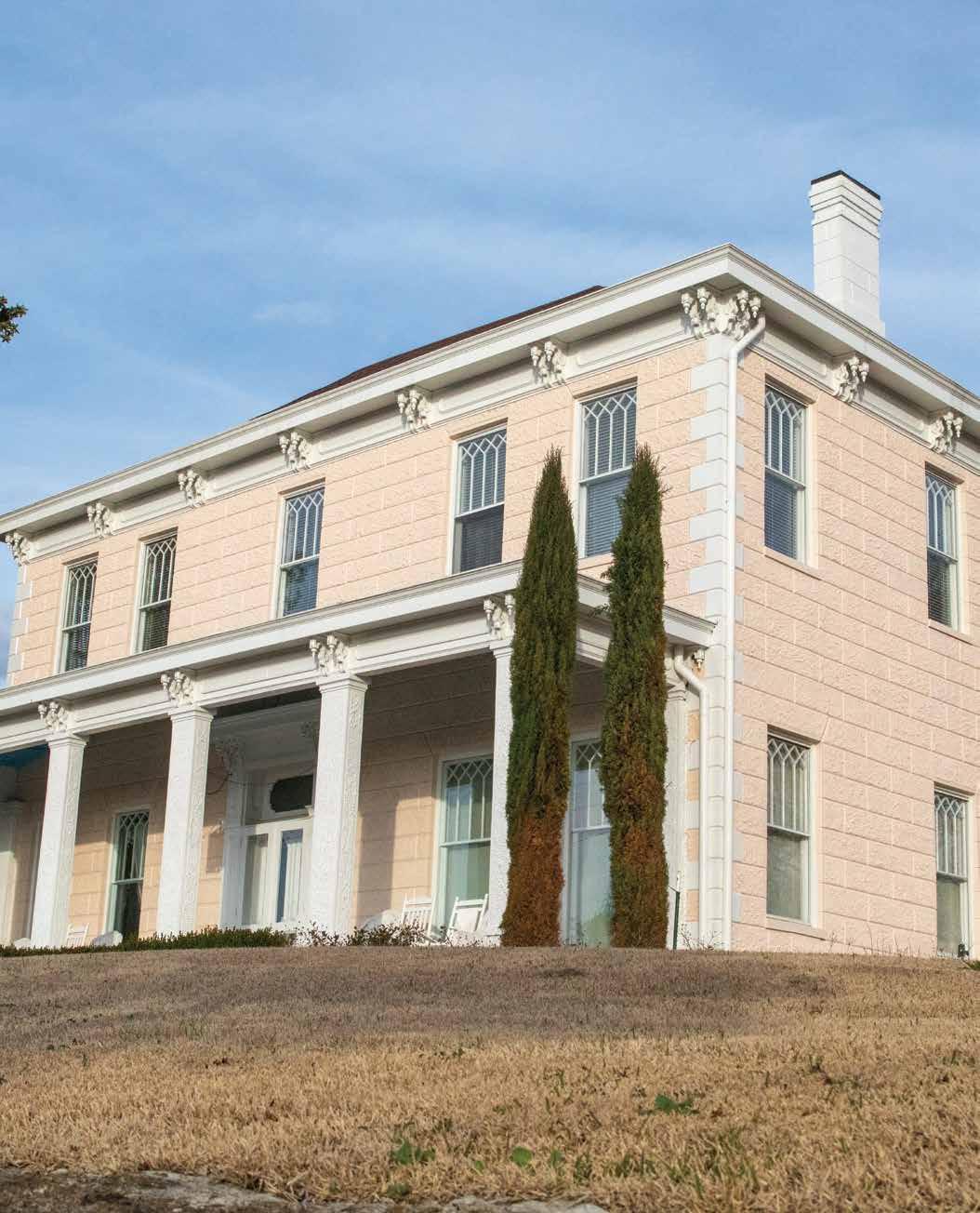
On the eve of the Civil War, Vicksburg was a booming commercial center and port.
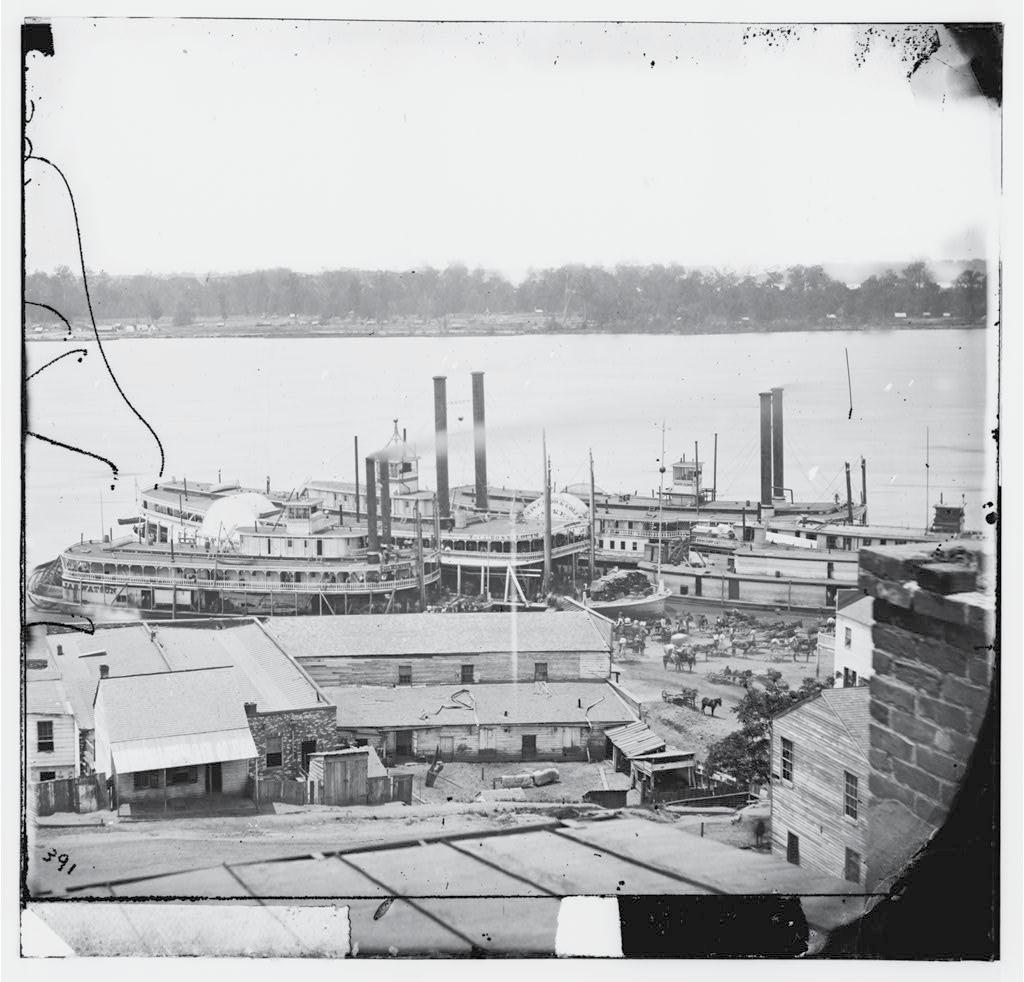
“At one point, Vicksburg was the biggest city on the river,” said Bubba Bolm, director and curator of the Old Court House Museum-Eva W. Davis Memorial.
In 1860, the population of Vicksburg was 5,000 people.
“The public wharf was crowded with steamboats, barges and pirogues ready for shipping and receiving goods from national and international markets for the city’s residents, and Levee Street was jammed with wagons, stacks of cotton bales and freight,”
writes Christopher Morris in his book “Becoming Southern: The Evolution of a way of Life, Warren County and Vicksburg, Mississippi, 1770-1860.”
By one account, more bales of hay were shipped from Vicksburg than any place in the state.
The river, the rail and the rich soil are what Bolm said led to Vicksburg’s success.
In his book, “Vicksburg: A People at War,” Peter F. Walker wrote that, “Steamboats arrived daily from New Orleans, Memphis, St. Louis and Louisville, Ky. Boats left three times a week for New Orleans and Memphis, and a Yazoo boat went to Greenwood. The
Vicksburg Post
“The new metropolis climbed the hillsides and boasted 100 buildings holding a variety of stores, insurance offices, lawyers’ and doctors’ offices, restaurants and taverns, small manufacturing businesses, four nurseries selling plants and hilltop mansions.”LIBRARY OF CONGRESS PHOTO Vicksburg levee and steamboats, February 1864.
rail line was the Vicksburg, Shreveport and Texas Railroad.
“The new metropolis climbed the hillsides and boasted 100 buildings holding a variety of stores, insurance offices, lawyers’ and doctors’ offices, restaurants and taverns, small manufacturing businesses, four nurseries selling plants and hilltop mansions.”
There were three hotels — the Washington, Prentiss House and the Commercial Hotel. Vicksburg also boasted a city hospital, six newspapers and an opera house where the top actors of the period performed.
“Vicksburg had many big theaters and actors and opera singers would come from all across the country to perform, like the Booth Brothers,” Bolm said.
Edwin Booth, brother of John Wilkes Booth, was considered one of the leading actors of his day.
The city had a cosmopolitan atmosphere. People came to Vicksburg from other areas like the East Coast,
other southern states and foreign countries.
One-quarter of the city’s free inhabitants were foreign-born. Eighty percent of the transplants came from England and Germany, but 17 countries in Europe and the Americas were also represented.
Morris wrote, “Signs hung over the shops along Washington Street reflected the ethnic mix of Vicksburg’s population. J.F. Baum fruit stand; Bazinsky and Simmons dry and clothing; Botto and Spengler coffee house; Antonio Genella general variety store; Francis Hernandes Havana cigars; Henry Volker shoemaker; Patrick Burns blacksmith; and A. J. Carnahan merchant tailor.”
“People had the finest furniture and clothing,” Bolm said, and downtown shops had fine silver, watches and clocks. “Had we been 50 miles off the river, we would not have had any of this,” he said.
Terry Winschel, retired Vicksburg
National Military Park Historian, said, “Because of the foreign immigrants, people heard foreign tongues spoken on the streets,” and the diversity was also reflected in the houses of worship. The Methodist, Baptist, Episcopal and Presbyterian churches were represented along with a Roman Catholic Church and a synagogue.
Washington Street was the center of commerce, featuring quality stores, offices, tailor shops and dressmakers, and would be for many years to come.
The city had the A.B. Reading and A.M. Paxton foundries, which made boilers for steamboats, plows, tools and later cannons for the Confederacy during the war.

According to “Vicksburg: A People at War,” the assessed value of personal and real property in the city in 1860 was $4,820,650, or about $164.5 million in today’s money.
Real estate was valued at $1.54 million or about $55.3 million, and the value of manufactured goods made in
Vicksburg totaled $643,700, or $23.1 million today.
“It was truly a bustling community,” Winschel said. “There was diversity in business. It had four fire stations — volunteers that were more like political organizations. They raced each other to fires and the first one there would stump political philosophy to the crowd watching the fire. Every once in a while, they would put a fire out.”
Politically, the people of Vicksburg were Whigs, Winschel said, which was common for river towns. One of the forerunners of the Republican Party, Whigs advocated protecting industry and limiting presidential powers.
Because of its political philosophy, Vicksburg’s residents, like those in Natchez, opposed secession because the towns had too much to lose by leaving the Union. Vicksburg’s representatives voted against secession at the state’s convention to determine
whether leave the Union.
In 1860, Vicksburg was governed by a board consisting of a mayor and four councilmen. Similar to today’s Board of Mayor and Aldermen, the pre-war board dealt with the business of running the city — budgets, making sure the city’s dirt streets, sidewalks and alleys were clean, handling complaints about derelict buildings and passing ordinances.
The effects of the Civil War were experienced by Vicksburg residents early in the war when a naval blockade blocked Southern ports and the Mississippi’s tributaries, reducing the goods coming to port and forcing layoffs and unemployment. When Union Flag Officer David Farragut captured New Orleans and Baton Rouge in the spring of 1862, supplies became even fewer.
The war hit closer to home when wounded from the Battle of Shiloh — fought April 6-7, 1862 in western Tennessee — came to the city by boat or train. The battle was one of the bloodiest of the Civil War, with 23,746 casualties, 10,699 of those Confederates. The Confederates had 1,728 killed and 8,012 wounded.
At the time, there was no fighting around Vicksburg, making it one of the safest places to be.
“Vicksburg would be a major hospital center for the confederacy in 1862,” Winschel said. “After the Battle of Shiloh, as the
wounded were being unloaded off the steamboats and taken into the city, many of the townspeople went down to offer assistance and they found their own sons.”
In May 1862, Union forces made their first appearance at Vicksburg.
The war forced the Board of Mayor and
Council to deal with new issues as soldiers passed through town going to battle and refugees came from captured areas.
The board on March 24, 1862, ordered the city’s bars to close early and suspended issuing new liquor licenses. It later declared martial law to discourage crime.

With its surrender on July 4, 1863, Vicksburg became an occupied city, Winschel said.
Vicksburg fell under military rule, which remained in place until Reconstruction ended in 1877, even though Mississippi had been re-admitted to the union in 1870.

Mississippi writer David Cohn spawned the phrase, “The Mississippi Delta begins in the lobby of the Peabody Hotel in Memphis and ends on Catfish Row in Vicksburg.”
This is evidenced by Vicksburg’s rolling hills and bluffs perched high above the Mississippi River.
It was these bluffs, rich in nutrients from their loess soil, that attracted the early 1800s settlers from the east.
“Its silt-sized particles (from the bluffs) allowed for easy access to water for plants
and it drained well making it easily ready for plowing and spring planting,” the Vicksburg National Military Park website reads.
Loess soil also remains stable when cut vertically, making for a unique terrain that was used by both the Union and Confederate soldiers during the Siege of Vicksburg. This physical feature allowed soldiers to construct trenches that provide shelter from cannons and artillery.
Caves could also be constructed in the loess soil, which is what many of the
townspeople did during the Siege.

In the July 1, 1963, Vicksburg Post anniversary edition, a story was written on cave life during the Siege titled “Birth, Death: Great Drama In Cave Life.” And in the story, an account, which is said to have been one of the “few published,” was given by Mrs. James M. (Mary) Loughborough, on cave life in Vicksburg.
Loughborough describes her cave as an
“excavation in the earth the size of a large room, high enough for the tallest person to stand perfectly erect, provided with comfortable seats and altogether quite a large and habitable abode.”


She explained further that the rooms were arched and braced, and these supports took up most of the room in the confined quarters.
“The cave was in the shape of a T,” Loughborough said, wherein one of the wings was the bed, and the other a dressing room. Mattresses had been dragged in for beds, she said, and mirrors and pictures adorned the walls. Loughborough said her cave also had a “tent fly that was stretched over the mouth of the cave to shield those inside from the sun.”
Days were endless sitting “idle” in the caves, she said, which was reiterated in Virginia Calohan Harrell’s book, “Vicksburg and the River.” Harrell writes of a survivor who shared their account of cave life with Mark Twain on how boring it had been living in the cave.
“It got to be Sunday all the time. Seven Sundays in the week, to us anyway. We hadn’t anything to do and time hung heavy,” the survivor told Twain.
While the caves were constructed to serve as protection against the bombardment, they were not foolproof. There was still the possibility of them giving way


Cadence Bank understands this and also realizes that everyone's experiences have not been the same. We want you to rest assured that throughout all of life's hardships and achievements, financial or otherwise, Cadence Bank always has been and always will be right here with you.

and live ammunition breaching the shelter.
Loughborough said one mother during the Siege had taken her child into the cave where she thought he would be safe. But that was not the case in this situation. A mortar shell came rushing through the air, she said, “And fell with such force that it cut through into the cave and crushed in the head of the sleeping child.”
Another instance saw new life brought forth in the caves. During an intense bout of shelling, the wife of Duff Green (for whom the mansion is named) birthed a son in a cave. She named her baby William Siege Green.
Cave life was an opportunity for some entrepreneurs.
In the same Post article, Dr. Peter Walker said, cave building was a “big business with set prices depending upon the size and elaborateness of the excavation.”
“For $20, a simple one-room affair could be dug. A deeper thick roofed, several-chambered cave, shored up by timber and with shelves cut into the earth, cost $50,” Walker said.

Caves could also be rented.
Some people preferred to rent.

“Mrs. M.L. Powell, whose comments on the Siege ran in The Post in 1934, recalled that her family rented two caves, one where the post office now stands and the other on Grove Street.” The article referred to the former U.S. Post Office building on Crawford Street, which is now vacant.
As stated in the story from July 1, 1963, “No tales of the Siege of Vicksburg had more drama, perhaps, than those recounted by the men, women and children who spent those 47 days underground in a cave.”

At one point during the Siege, Vicksburg was a city of hospitals — and their locations might be surprising.

“During the Siege, public buildings and later private residences were used to treat the wounded,” said Terry Winschel, retired Vicksburg National Military Park historian.


But in the 30 years before Gen. Ulysses S. Grant laid siege to the city, Vicksburg had already gone through two hospitals. The first, said Nancy Bell, executive director of the Vicksburg Foundation for Historic Preservation, was a house acquired by the city in 1832. Records did not give the location of the building, she said,
saying only it was located “back of town,” outside the city limits.



When the building burned down in the 1840s, the city acquired a building in 1847 known as the Reading House, on what is now the former Kuhn Hospital property, for $1,200 to serve as the new hospital.
The hospital served the needs of the city until April 1862, when the Confederate Army began shipping its wounded from the Battle of Shiloh in Tennessee to Vicksburg for treatment and recovery.

“Hospitals served wounded from Shiloh and there were some hospitals besides the city hospital in the city,” said local historian Tommy Presson.





“One was Cox hospital near the battlefield in the Jewish Cemetery and it was in 1862.”
He said wounded sailors from the Confederate ironclad ram Arkansas were taken to the Cox Hospital. Also, he said the Apollo Theater in the downtown area was in use in 1862 as well as the Verandah, a house located where the Warren County-Vicksburg library is now.
“Confederate hospitals expanded after wounded arrived from the battle of Shiloh in 1862, and some of the soldiers who were hospitalized were from Vicksburg so their parents were able to administer them as well,” Winschel said.
He said Vicksburg, which was considered a major city at the time, was considered a Confederate hospital town early in the war because of its water and rail access.
The number of hospitals varied, but one list of 30 hospitals operating during the Siege listed 17 private homes, including Duff Green mansion, that were used during the Siege.
The city had several major hospitals, including three designated “General Hospital 1,” “General Hospital 2” and “General Hospital 3.”
In his book, “Vicksburg: A Southern City Under Siege,” William Lovelace Foster, a chaplain for the 34th Mississippi, described Hospital 1 as being “situated about a quar-
ter of a mile behind our lines.
“The building where the sick remained and where cooking was done was located on a high hill, a beautiful residence. The wounded were placed in tents on either side in deep hollows.”
But the three general hospitals were not the only major hospitals in the area.
“The Washington Hotel was a major hospital, and so was Duff Green and the Marine hospital,” Presson said. “The city hospital was first used by the Confederates and then used by the Union. They called it McPherson’s Hospital (after Union Gen. James B. McPherson).”
Located on Speed Street, the Marine Hospital was built in 1853 to serve sick or disabled merchant seamen.
On the battlefield, Confederate and Union troops were served by aid stations and field hospitals.
“Union hospitals had the three Corps hospitals — major — hospitals and field hospitals scattered on battlefields,” Presson said. “It was the same with the Confederates; they had field hospitals set up behind the lines to treat wounds. Some men, if they weren’t badly wounded, they would treat them and get them back on the lines. If the injury was more serious they would try and get them stable enough to move to a larger hospital.”
“If someone was wounded or fell sick,
they were immediately escorted behind the lines and then transferred to a more elaborate facility,” Winschel said of the Union facilities. “The north also had hospital boats on the Yazoo River not far from Chickasaw Bayou — the Red Rover was moored out there.

“They had huge tent hospitals out by Chickasaw Bayou. The seriously wounded or sick were sent to Van Buren Hospital by Milliken’s Bend or sent farther to the rear to Memphis or St. Louis,” he said.
The hospitals in Vicksburg were staffed by military and civilian doctors and nurses, including the Sisters of Mercy, who also later treated Union wounded.
Conditions in the hospitals, Presson said, “were pretty bad.”
“Most people think they were barbaric but they did have anesthesia they used for amputations and there were a lot of amputations. If you got shot in the arm or the leg, the only thing they could do was amputate. If you were shot in the head or vital place you were considered dead,” he said.
“Medicine was in short supply and the wounded men suffered terribly, not only from the heat and humidity but lack of food, water and improper medical treatment,” Winschel said.
Those problems, Presson and Winschel said, allowed disease to spread rampantly through the ranks in Vicksburg in both the
Confederate and Union forces.
According to the Battlefield Trust, of the 620,000 soldiers who died in the war, twothirds of these deaths were from disease.
And cannon and mortar fire from Union troops and mortar barges caused another problem.
Winschel said hospitals flew a yellow flag flying with a green “H” for hospital. Both sides respected the flags, but there were no such things as the precision munitions of today and unfortunately for the wounded, the Confederate battery positions in town were located near hospitals on the waterfront.
“The union mortars fired in the direction of the union battery. Sometimes, they hit, sometimes they missed and sometimes they missed and they hit hospitals,” he said.
Continuous artillery fire, Presson said, forced the closure of General Hospital No. 1 and its wounded were moved to the Washington Hotel.
At the end of the Siege, many of the hospitals were slowly closed, although some remained open until the occupation ended in the 1870s. Some, like the Pest House on Old Jackson Road, which was named because it treated patients with diseases, remained open until the 20th century.

“The Washington Hotel was a major hospital, and so was Duff Green and the Marine hospital. The city hospital was first used by the Confederates and then used by the Union. They called it McPherson’s Hospital (after Union Gen. James B. McPherson).”PHOTO FROM THE OLD COURT HOUSE MUSEUM ARCHIVES Marine Hospital. FROM THE OLD COURT HOUSE MUSEUM ARCHIVES A map of early hospitals and Civil War hospitals in Vicksburg.
 By Terri Cowart Frazier | The Vicksburg Post
By Terri Cowart Frazier | The Vicksburg Post

In 1860, six members of the Sisters of Mercy began what became a legacy of service and commitment to the community. Much of what they started is evidenced through what is now known as the Southern Cultural Heritage Center.
Arriving from Baltimore, the Sisters’ mission was to start a school for Black and white students because there was not one in the area. They purchased the John D. Cobb house, located at 1101 Crawford St., to serve as their
school and a convent.
They paid $8,000 for the home, which is equivalent to about $300,000 today, and began teaching.
When the Civil War began and the fighting grew closer to Vicksburg in 1862, the Sisters relinquished their mission of educating children, closed the school and began traveling throughout Mississippi and surrounding states caring for both Union and Confederate soldiers.
In a Vicksburg Post article written by Karen Gamble, she quoted the late Gordon Cotton, longtime curator of the Old Courthouse Museum, historian and author as saying, “The presidents of both sides praised the sisters. ‘I can never forget your kindness to the sick and wounded during our darkest days,’ Jefferson Davis, the president of the Confederacy, said after the war. On the opposite side, President Abraham Lincoln referred to the sisters as ‘… the most efficient … veritable angels of mercy.’”
While taking care of the wounded, the Sisters of Mercy’s school and convent served as barracks first for the army of Confederate General John C. Pemberton before the surrender of Vicksburg on July 4, 1863, and later by Federal General Henry Slocum.
It was on Aug. 15, 1864, when the Sisters were able to reclaim their school and convent, reopening in the following month.
In 1868, the Sisters added a convent building for $30,000. The Saint Francis Xavier Convent was located east of the Cobb House. The L-shaped, three-and-a-halfstory Gothic Revival structure was designed by Father Jean Baptiste Mouton.
According to waymarking.com, the plan of the convent was derived from “period domestic architecture, rather than from any specialized functional arrangement.”
Today the structure is one of the most prominent and best-preserved examples of 19th-century Gothic Revival architecture in Mississippi.
The Sisters continued their teaching ministry while also taking care of the sick, which following the Civil War included caring for those affected by the 1870 yellow fever epidemic.


In 1885, the Sisters of Mercy added a building to their property, this time a two-story Italianate auditorium for $24,000. In deciding on the design for the facility, the SCHF website said, the Sisters “examined similar structures in Chicago.”
The school continued to grow and in 1937 an annex to the convent building was added as well as a “modern academy building” behind the auditorium. The final addition to the school was in 1953 when the O’Beirne Gymnasium was completed.
The Sisters of Mercy taught in these buildings from 1860 until 1991 when the few remaining nuns moved to a new convent and the school relocated to more modern facilities.
In 1994, the city of Vicksburg bought the block in which the five buildings are located, and in 2001, signed over the deed to what is now the Southern Cultural Heritage Foundation.
From teaching to taking care of the sick, the Sisters of Mercy’s loving arms reached far and wide in the Vicksburg community.
According to Gamble’s article, the Sisters helped with the polio outbreak in the 1940s. In 1943, they took over Vicksburg’s Street Hospital and nursing school.
“Through the next 20 years,” Gamble wrote, “the sisters began operations of Mercy Hospital, later Mercy Regional Medical Center, and Mercy School of Nursing. The school educated and trained nurses for the entire state of Mississippi and much of the Southeast until establishing a three-year degree program with the University of Southern Mississippi and later a two-year program with Hinds Community College.”
The last of the Sisters of Mercy moved from Vicksburg in 2019, leaving behind a more than 150-year-old indelible legacy.




















Relish
BEST Italian
Bring your friends and family to experience our American cuisine with Italian influences in a casual atmosphere.
Come and enjoy our Sunday jazz brunches. Fall in love with our pastas that are made fresh daily. The catch of the day changes weekly and is always an excellent choice!
We take the quality of our ingredients to heart and source locally and organically when available
RELISH BISTRO, LLC

TRAVELERS REST
By John Surratt | The Vicksburg Post
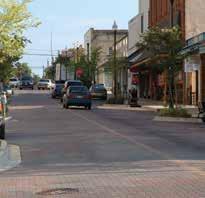
Rest Missionary Baptist Church has provided its members with spiritual guidance and support and in later years provided education for area children through its Travelers Rest Academy.
According to the church’s history, Travelers Rest’s story began with a small group of people who met in 1913 in a home on Reed Street.
As the congregation grew, it moved to a home at the intersection of Madison and Levee streets and by 1922 moved into a building on Pearl Street under the leadership of the Rev. John I. Williams. Under Williams, the church held its first revival, which brought an additional 27 people into the fold, the junior and senior choirs were formed and the church’s missionary society and usher board were formed.
Williams served as pastor until 1932 and was succeeded by the Rev. Joseph Henry Williams, who served until his death in 1972. During his tenure as pastor, the church was severely damaged by fire and then rebuilt on the same site.
ince its formation, Travelersis now Crossways Church.

Travelers Rest Academy opened in 2001 with 15 children and grew to 175 children from 6 months to sixth grade before closing.

In a July Vicksburg Post article on the school’s reopening, school director Janet Watts said the idea for the school began in 2000, with Bernard.
“He said we have a lot of students here and he said we needed to start our own school,” Watts said. “By him saying that, and I was an educator, I said ‘OK,’ so we started the school.
“We got a lot of help from Porter’s Chapel Academy when we first began,” Watts said. “They showed us how to get accredited and showed us how to get this school started in a Christian way.”
Bowmar Elementary, she said, helped when Traveler’s Rest got ready for reading and science fairs by allowing the school to hold its fairs at the school.
At the time, Watts said, Travelers Rest Academy “was a great school; well-known all over Mississippi.”
Contact: Keith O’Keefe, PE Central Mississippi Manager keith.okeefe@neel-schaffer.com

601-534-1791
1100 Cherry Street, Vicksburg, MS 39183
Williams was succeeded by the Rev. Thomas Baldwin, who served as pastor until his death in 1991 and was succeeded by the Rev. Thomas E. Bernard, who later became Travelers Rest’s first full-time pastor who was involved in the development of church outreach programs and the transition in 1994 from the church holding two services a month to every Sunday.
Also during this period, according to the church’s history, Travelers Rest held its first leadership conference and became incorporated with bylaws. The church later purchased a two-story house for tutoring and mentoring youth and in 2000, the church acquired its recent home, buying the Bowmar Avenue Baptist Church after that congregation left to become what
The school uses the Abeka curriculum, which is a Christian education program.

“Everything is Christian, including the Bible,” Watts said. “We are non-denominational as far as school is concerned, but the church is Baptist.”
“We will not teach Baptist doctrine,” said the Rev. Dr. General Bryant Jr., Travelers Rest’s present pastor.
Bryant said he is excited about the school’s return.
“I’ve heard a lot about school life,” he said. “Prior to coming here from Tallahassee, Fla., I did my research on it and they had a lot of positive things to say about the school. I also talked to local officials and a lot of them came through this school or their children came through this school. They are very excited.”

In the midst of the explosions and destruction by shells and rounds from Union gunboats and mortar barges during the siege of Vicksburg, one thing remained constant — daily services at Christ Episcopal Church.
“The church of which my father was rector was the only church in Vicksburg — with the exception of the Roman Catholic Cathedral — where services were held during the Siege,” William Lord Jr., the son of church rector the Rev. W.W. Lord, wrote in a 1908 Harper’s Magazine article on the Siege.

“As far as we know, it was every day,” said the Rev. Sam Godfrey, rector of Christ Episcopal Church.
“Sunday was the regular Sunday service and out of the 1836 ‘Book of Common Prayer,’” said church member Dave Benway. “Back then they would have had morning prayer, probably, during the day. Once a month, they had Communion.
“The middle of the week services may have been shorter but at the same time, if people took the trouble to get here, they would have
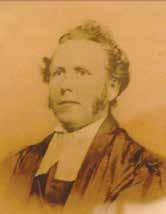
possibly made it just as long,” Benway added.
Christ Episcopal was organized in 1826, the year after Vicksburg was incorporated.
Construction on the church building that stands on Main Street began in 1839, with Bishop Leonidas Polk laying the cornerstone. Pope would later become a Confederate general and receive the nickname “the Fighting Bishop.” He was killed in battle at Pine Mountain, Georgia, in 1864.
The church’s foundation was brick and mortar with a basement. According to William Lord, the church basement served as a shelter for the Lord family at some point during the shelling.
The family, without Rev. Lord, eventually relocated to a plantation in Flowers before returning and joining other Vicksburg residents in a cave to seek shelter from shelling.
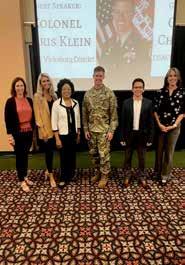
And like many buildings in the city, the church and rectory were damaged.
“The windows here (in the present church) are not original,” Godfrey said, pointing out that all but one stained glass window was lost during the Siege.”
“The other windows weren’t blown
out by artillery, but were damaged by the concussion from the shells and cannonballs hitting nearby,” he added.
“The church was not damaged that much during the Siege.”
The lone window to survive, he said, was a German stained glass window installed in 1855.
“For years the story was that the church had not been hit, but in 1953 when the tornado hit Vicksburg they went upstairs to inspect the belfry and they found a cannonball,” Godfrey said.



“But the rectory was totaled (from shelling),” Benway said. The shelling, he added, wasn’t just from mortars. “The ships had rifled cannons.”
Godfrey said Lord’s wife Margaret
described the damage as “a scene of desolation.
“The dressing room was in ruins, the end where the fireplace had been was blown entirely out; the nursery uninhabitable — a hole deep almost as a cistern in the middle of the floor. Every room in the house was injured and hardly a window was left whole.”
When Gen. John Pemberton surrendered Vicksburg, Lord and his family left the city under a pass from Gen. Ulysses S. Grant. Lord would later return to Vicksburg after the Civil War and become the first rector of the Church of the Holy Trinity.
More than five months after the city’s surrender, Christ Episcopal was the scene of a protest by four women





(five, by one account) whose objection to a Union order that violated the Constitution’s provisions on separation of church and state resulted in their being banned from the city for the remainder of the Civil War.


The incident involved an order requiring churches in the areas occupied by Union troops to say a “Prayer for all those in Civil Authority,” which according to local accounts of the incident was called the “prayer for the president.”
According to accounts, a former rector serving as rector until another priest could arrive said a prayer for the president, the ladies walked out of the service and were later arrested and sent to Bovina.


“The dressing room was in ruins, the end where the fireplace had been was blown entirely out; the nursery uninhabitable — a hole deep almost as a cistern in the middle of the floor. Every room in the house was injured and hardly a window was left whole.”

 PHOTO BY BEN MARTIN | THE VICKSBURG POST Bryan Pratt stands in front of the Featherston-Magruder House on Cherry Street, holding remnants of a mortar shell he found there as a child.
PHOTO BY BEN MARTIN | THE VICKSBURG POST Bryan Pratt stands in front of the Featherston-Magruder House on Cherry Street, holding remnants of a mortar shell he found there as a child.



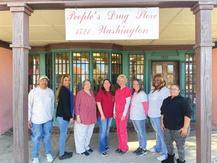


When Bryan Pratt was growing up, his family owned a number of properties around Vicksburg. When he was about 6 or 7 years old, his great aunt was having renovations done to one of the buildings she owned, the historic Featherston Magruder House on Cherry Street, when a treasure was uncovered.

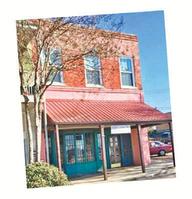

“We would go there after school, and the workers were fixing some termite damage in the floor,” Pratt said. “They were down there digging to put a piling in or something to fix the floor joist, and this was there.”


The construction workers had made an interesting discovery: two large fragments of a mortar round, probably fired from a Union gunship during the Siege of Vicksburg.
A mortar was a stubby, powerful cannon that could fire a heavy projectile in a high arc, which allowed it to hit targets that would have been
too obstructed for a gun (a cannon that would produce a more horizontal trajectory for its projectile).


Charles Pendleton, the owner of the Civil War Museum in downtown Vicksburg, said these kinds of mortars were generally too large to easily move on land, and those being used at the Siege of Vicksburg were almost certainly stationed on gunboats.


“They’d shoot from Lake Centennial over the current canal all the way up there,” Pratt said. “And the Union used the courthouse to sight from, but they would never shoot at it. They would use it to get their orientation for where they wanted to hit.”
Lake Centennial, located on the other side of the Yazoo River, was not a lake during the siege. It was, in fact, a part of the main artery of the Mississippi River. Decades of meandering and major advances in river dredging technology have resulted
in the layout residents are familiar with today.




Union gunboats stationed on the part of the river adjacent to the downtown area of Vicksburg would have made easy targets for Confederate artillery. The area of Lake Centennial would have provided significantly more cover between Union and Confederate forces.
Pratt recently brought the fragments to Pendleton to see what he could find out about the projectile. Pendleton helped determine that the fragments were part of a spherical shell that measured 13 inches in diameter, given the fact that the wall of the shell was 2 1/2 inches thick.
Although Pratt’s two fragments are only a portion of the whole projectile, they are quite heavy.

The entire projectile would have comprised the 2 1/2 thick solid iron casing


that encased explosives that would be set off by a delayed fuse or by impact. The whole assembly would have weighed approximately 200 pounds. Often, the explosives inside the shell would have included smaller projectiles for increased carnage.

The Featherston Magruder House is located on Cherry Street next to the Warren County Jail and was originally built as a one-story school building in 1831. During the Civil War, it was owned by Dr. Alex Magruder, who was not in Vicksburg at the time of the Siege.

In the 1900s, Pratt’s great-grandfather, Tom Morrisey, purchased the home. It then stayed in his family for several generations.

Pratt said he has never really done much with the shell fragments in the way of exhibition — but they make for a pretty interesting conversation piece.















Every year, thousands of tourists visit the Vicksburg National Military Park to absorb its history. For locals, it’s a popular place to walk, run and bike.
For art aficionados, meanwhile, it is a hidden gem.
There are nearly 1,400 monuments, markers, memorials, statues and sculptures packed into the Park’s 1,800 acres. The pieces range from simple iron or stone tablets to massive state monuments
By Ernest Bowker | The Vicksburg Postand bronze statues.

The art is more than decorative. Lifesize busts of commanding officers and the haunting gazes of common soldiers bring the men who fought and died during the Siege of Vicksburg in 1863 to life 160 years later.


“I do think it personifies it,” said Bess Averett, the executive director of Friends of the Vicksburg National Military Park and Campaign. “It’s easy to think about this as being something in the past that

happened to other people a long time ago. I think that’s what’s so signifcant about our park. We have been called ‘the art park of the National Park Service’ because of the scale and the degree of the monumentation.”
The size and scope of the monumentation is certainly impressive. Monuments of all shapes and sizes are scattered along the length of the VNMP’s 16-mile long Tour Road.
Ohio, for example, has monuments for






BELOW: A monument honoring the 48th Ohio Infantry regiment sits in the Vicksburg National Military Park. It is one of more than 1,400 monuments in the park. RIGHT: A cannon at Battery de Golyer in the Vicksburg National Military Park.



Besides finding granite and bronze “easter eggs” off the beaten path, visitors who get out of their cars to get a
emotion. Some of the scenes on Iowa and Missouri, the bronze reliefs, you see the faces of the soldiers as they’re
 The Minnesota Monument in the Vicksburg National Military Park.
A bust of Confederate Gen. John S. Bowen is on display in the Vicksburg National Military Park.
The Minnesota Monument in the Vicksburg National Military Park.
A bust of Confederate Gen. John S. Bowen is on display in the Vicksburg National Military Park.
BELOW: A monument honoring Indiana units sits in the Vicksburg National Military Park. RIGHT: A bulletshaped monument honoring the 53rd Ohio Infantry Regiment is one of 39 in the VNMP that recognizes the service of that state’s soldiers.



stagnant.”
Like the placement of each monument, the level of detail is no accident. The elements






 By Ernest Bowker | The Vicksburg Post
By Ernest Bowker | The Vicksburg Post

Abraham Lincoln was the United States president during the Civil War. Old Abe — a bald eagle named for the president — might have been a bigger celebrity.
Two years before the Siege, in 1861, the bird was captured by a Chippewa Indian named Chief Sky, who sold him to Daniel McCann for a bushel of corn. McCann, in turn, sold him to members of the “Eau Claire Badgers” militia company at a marshaling site in Madison, Wisconsin.
The Eau Claire Badgers were redesignated as Company C, 8th Wisconsin Volunteer Infantry Regiment when they entered federal service. Because of the eagle, the unit also earned the nickname the “Eagle Regiment.” The eagle was named “Old Abe,” in honor of President Lincoln.
The 8th Wisconsin served with distinction in the Western Theater during the Civil War, including the Vicksburg campaign. Old Abe accompanied the 8th Wisconsin through 25 battles and a number of skirmishes. Old Abe was typically secured
with a long cord attached to a perch, and his handlers carried the 14-pound bird into battle the same way they would the flag.
“While I was his bearer I taught him to drink water out of a canteen which saved him a great deal of suffering on long hot marches in a dry country,” David McLain, one of Old Abe’s wartime handlers, said at a meeting of the Dunn County (Wisconsin) Old Settlers Association in the late 1800’s. A manuscript of McLain’s speech was passed down through his family and published by the Eau Claire Leader Telegram newspaper in 1976. “By this time Old Abe was getting quite heavy. I think about 12 or 14 pounds and on hot days very troublesome. When he would get tired on his perch he would want to fly to the ground to rest, but we got along with him pretty well.”
Feeding Old Abe wasn’t as easy as teaching him to drink. McLain said the eagle’s appetite was finicky.
“He would not eat grain of any kind. Sometimes we could get a chicken or a duck for him. He was quite fond of minnows, quite often we could get some in the creeks and then he would have a feast,” McLain said. “He was very particular about what he ate. He would not touch meat of any kind that was the least tainted. We always did the best we could to get rations for the eagle, as we were very proud of him.”
And rightly so. Old Abe was as much a comrade in arms as he was a mascot.
Old Abe’s time in the army ended in 1864 but not his revered status. He quickly became a national celebrity and a state symbol in Wisconsin. Old Abe was sent around the country to veterans’ reunions, benefit events, and was part of the Centennial Exposition in 1876. Eventually, he was moved to an aviary in the Wisconsin state capitol building.
Sadly, Old Abe was injured in a small fire in 1881 and died a month later. His body was preserved and displayed in the state capitol until 1904, when another fire destroyed the building and Abe’s remains. Only a few of Abe’s feathers remain today, but his legacy is as large as ever.
Old Abe’s likeness stands atop the
Wisconsin monument in the Vicksburg National Military Park, as well as the entrance to the University of Wisconsin’s Camp Randall football stadium. A replica of Old Abe presides over the Wisconsin State Assembly chamber in the state capitol. Eau Claire Memorial High School’s sports teams are nicknamed “Old Abes.”
Perhaps most famously, Abe’s profile adorns the shoulder sleeve insignia of the U.S. Army’s 101st Airborne Division. That unit was established at Mississippi’s Camp Shelby in 1918, then reconstituted in Milwaukee, Wisconsin in 1921 — where Old Abe and the “screaming eagle” mascot was adopted.
The 101st was reorganized as a paratrooper division in 1942 and became famous for its battles across Europe during World War II.
The 101st has continued to fight on, through Vietnam, Iraq, Afghanistan and other hotspots around the world. Old Abe has flown alongside every step of the way, just as he went into battle with the 8th Wisconsin at Vicksburg in 1863.





 By Terri Cowart Frazier and Ben Martin | The Vicksburg Post
By Terri Cowart Frazier and Ben Martin | The Vicksburg Post
Thousands arrive each year in Vicksburg to learn about its history. These visitors are eager to hear about the people who once walked along the brick streets, to visit historical homes and landmarks, and view the many relics left behind.
Vicksburg residents Charles Pendleton and Bubba Bolm spend their days surrounded by artifacts. Pendleton is the owner of the Vicksburg Civil War Museum and Bolm is the curator and director of the Old Court House Museum. Both men were asked what their favorite relics were and why, from their respective museums.
The building (Old Court House) itself is the most historic structure in the area. It has been witness to the events in our community since 1858 and is the most interesting “artifact” from the Siege. There are thousands of items with provenance within the wall of the Old Court House and it is difficult to pick favorites. The McCardle Library on the first floor is a researcher’s dream come true. Those who seek genealogy information, local cultural history, information about the Siege, etc. can find it here among the hundreds of family files, soldier







and civilian diaries and memoirs, and thousands of rare photographs. A true insight into how the soldiers of both North and South and local families lived through the Siege.
The Provost Marshall Records for the Occupation of Vicksburg are the actual handwritten records dating from July 5, 1863, thru 1865. They list the regulations and names of soldiers from both sides as well as civilians, who were brought before the provost for offenses during a very difficult time in our history.

We have two very rare cannons — A 9,200-pound Dahlgren Shell Gun manufactured at Fort Pitt Foundry in 1862. The gun served on the USS Tuscumbia and later with the 17th Corps. The gun took a crew of 17 to man it. The second is a three-inch Bronze rifled cannon made here in Vicksburg (1862) by A.B. Reading and Brother Foundry.
The chair that U.S. Grant used at his headquarters in Vicksburg.
The graffiti was carved into the glass and slate around the building.

A beautiful table handmade by a Sgt. Davis from Iowa. Davis was placed in the home of Owen Trainor following the surrender. Davis befriended the Trainor’s daughter Ann, who reminded him of his child back home. He made Ann the table with her initials in three of the corners. One of the acorns on the base was carved from the wood of the tree under which Generals Grant and Pemberton negotiated the surrender of Vicksburg.
Charles Pendleton produced two muster rolls from his collection of the 9th and 43rd U.S. Colored Infantry regiments.

“It lists everything about them that day, if they were injured, all that kind of stuff,” he said. “But the most important or significant thing about (these) is that they were present at Appomattox at the surrender of the army of Northern Virginia.”



A muster roll is a regular report of a company of troops that would list identifying information and status, among other things.



“Many of the Black soldiers that (fought) died before they saw freedom. These guys were able to witness it. And I think that was really, really important,” Pendleton said.
Pendleton was also excited to show off several types of artillery shells.
One shell in particular appeared to




be in rougher condition. The projectile itself was a metal sphere several inches across. A small piece of wood clung to it by thin metal straps. The shells in this display were all found in Vicksburg.
“Now keep in mind, we’re coming up this year to the 160th anniversary of the surrender of Vicksburg. So most of these artifacts are at least 160 years old,” Pendleton said. “And this one is a six-pound bormann ball, and it’s still got the wood sabot on it. And for wood to survive 160 years buried in the ground is absolutely remarkable.”



The sabot was a simple device attached to the shell that would ensure the correct orientation of the round of ammunition when placed in the barrel.
Another item Pendleton displayed was an 1860 Henry Rifle, a lever-action rifle that could deliver multiple shots in quick succession. This was a significant advantage in a time when most soldiers were equipped with muzzle-loading rifles that in well-trained hands could produce only one shot every 20 seconds.
The rifle itself was in some ways a draw for recruitment, Pendleton said.









“The 3rd U.S. Volunteers were issued these rifles. And as part of their service, not only (were they) paid, but when their service was up, they got to keep their rifle and the other equipment that they were issued,” Pendleton

“Now keep in mind, we’re coming up this year to the 160th anniversary of the surrender of Vicksburg. So most of these artifacts are at least 160 years old. And this one is a six-pound bormann ball, and it’s still got the wood sabot on it. And for wood to survive 160 years buried in the ground is absolutely remarkable.”
said. “So for a lot of guys, that was the incentive that pushed them to volunteer.”
Some officers had reservations about the new weapon, however.
“Ironically, the officers in the military didn’t like the repeating rifles because they felt like the guys would use up too much ammunition,” he added.

Today, weapons that were used by the confederacy are not nearly as common as those used by the Union. And a Confederate weapon can fetch a significantly higher price among collectors.

“When you have a really good Union weapon on the high end, you would pay $5,000. For a Confederate weapon, you could pay $30,000 to $50,000,” Pendleton said.
The Vicksburg Civil War Museum opened in 2021 and is packed full of a wide variety of artifacts from the Civil War, particularly artifacts from the Siege of Vicksburg. It is located at 1123 Washington Street in downtown Vicksburg and is open Monday through Saturday from 9 a.m. to 6 p.m. and Sunday from noon to 5 p.m.


One of the biggest mysteries of the Siege of Vicksburg concerns the famous cannon, Whistling Dick, and what happened to it after the Siege.

Legend has it that it was dumped into the Mississippi River prior to the surrender of Vicksburg.
Whistling Dick was an iron, rifled and banded 18-pounder. It fired a
projectile 5.3 inches in diameter. One report written about it said that it made a screeching, whistling sound, that sounded like a tortured thing. Its sound, and the legend surrounding it, made the cannon a target for the Union. Stories told at the time describe the cannon in a much grander scale than it likely actually was. This served to confuse the
Union troops about its location, but unfortunately, likely also led to the cannon being lost to history following the Siege.
It was located in the Railroad Battery, which was located on Washington Street where the railroad tunnel passes under that street. It was damaged on May 22, repaired at A.M. Paxton’s foundry, then sent to the rear
Unified Brands takes great pride in being part of the commercial food service industry, which historically has provided venues for people throughout the world to gather, socialize, celebrate, remember, and serve. It is an industry built around individuals and relationships. And these relationships are what uniquely distinguish us among food equipment companies in the commercial food service industry.

Unified Brands is grateful to now be part of Electrolux Professional Group, and to call the historic community of Vicksburg, MS our US headquarters.




lines to an area alongside the railroad, and behind the current VWSD administration building, on Baldwins Ferry Road.
As of 30 years ago, the earthworks were still there.

The river at Vicksburg was heavily defended by several batteries with large caliber cannons, which made it nearly impossible for the Union fleet to pass Vicksburg. Among these cannons was the Widow Blakely, a 7.44-inch rifled cannon. It was imported from England and was used in the battery at the intersection of Washington and Bowmar streets.
A report in the Official Records of the War of the Rebellion by Samuel Lockett states; “On the 29th, the usual repairs and improvements continued along the whole line: a new battery made in the rear of the line left of Hall’s Ferry road; the new battery in the rear of General Lee improved, and ‘Whistling Dick’ (an 18-pounder rifled piece) put in position, and a new battery started in rear of General Moore’s center, but the working party was driven off by the enemy’s sharpshooters, and the work stopped.”
The Union Navy was responsible for starting the legend about Whistling Dick, although it is obvious they got Whistling Dick confused with a much larger cannon. At first, they misidentified the Widow Blakey as Whistling Dick, and the Widow fit the bill because it was the largest rifled
cannon in the defenses.
The only problem with that is that the Widow was disabled on June 22. A rifled and banded 32-pounder was also misidentified as Whistling Dick. That cannon was pictured on the sign for the Whistling Dick service station years later.

Researchers believe the Union Navy was thinking that the 7-inch triple-banded Brooke cannon in the upper batter was Whistling Dick. It was a formidable cannon that fired a 7-inch projectile until it burst at the breach on July 28.
What happened to the real Whistling Dick is nothing more than a myth. A former Confederate soldier, Lamar Fontaine, claimed that he was part of a group that was tasked with dumping the cannon in the river on the night of July 3.
Some have suggested that it was buried.


Researchers tend to think that it was overlooked by the Union forces because it didn’t fit their vision of what Whistling Dick would look like. More than likely, it was melted down because it was an obsolete caliber and was of no use to the Union forces.

To this day, no one knows for sure what happened to Whistling Dick.
Tommy Presson is a Vicksburg native with a lifelong love of the area’s history. Presson is the former manager of the Grand Gulf Military Monument and the Port Gibson Battlefield.
9 5 6






